Healthcare: Patient Care, Ethics, Insurance, and Employer Plans
VerifiedAdded on 2022/11/26
|8
|1969
|265
Homework Assignment
AI Summary
This assignment delves into various aspects of healthcare, commencing with a discussion on patient-centered care and the evolving perception of patients, differentiating between active and passive roles, and highlighting the importance of mental well-being. It then explores the roles of community and clinical nurses, contrasting their focuses and responsibilities. The assignment further examines the historical development of nursing ethics, tracing the evolution of ethical codes and their impact on patient-nurse relationships, education, and research. The discussion extends to managed care, analyzing its cost-control mechanisms, the compromises it entails, and its limitations. Finally, the assignment investigates employer-sponsored health insurance plans, their historical context, and the distinctions between employer-based and individual private plans, examining their respective advantages and impacts on healthcare coverage.
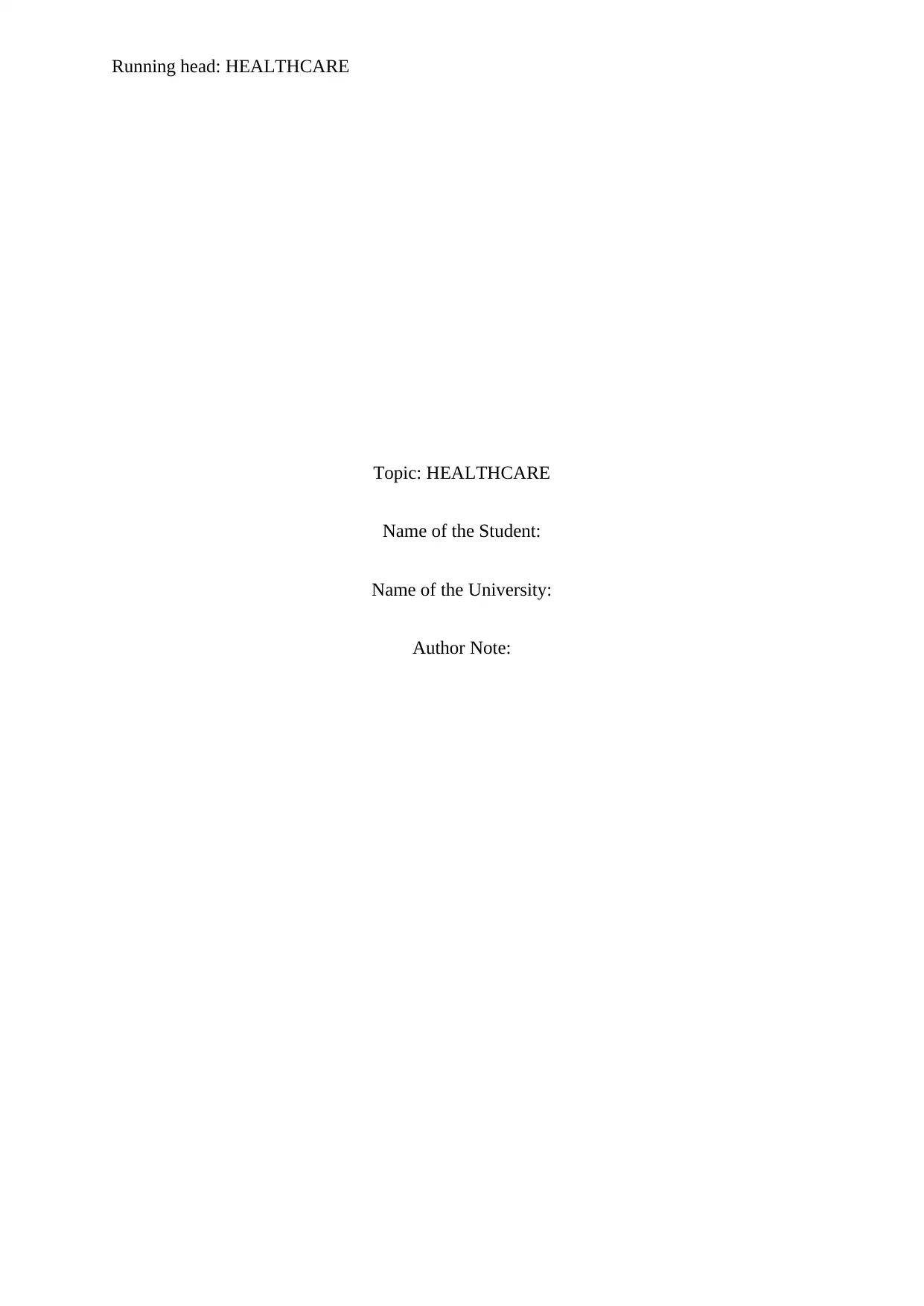
Running head: HEALTHCARE
Topic: HEALTHCARE
Name of the Student:
Name of the University:
Author Note:
Topic: HEALTHCARE
Name of the Student:
Name of the University:
Author Note:
Paraphrase This Document
Need a fresh take? Get an instant paraphrase of this document with our AI Paraphraser
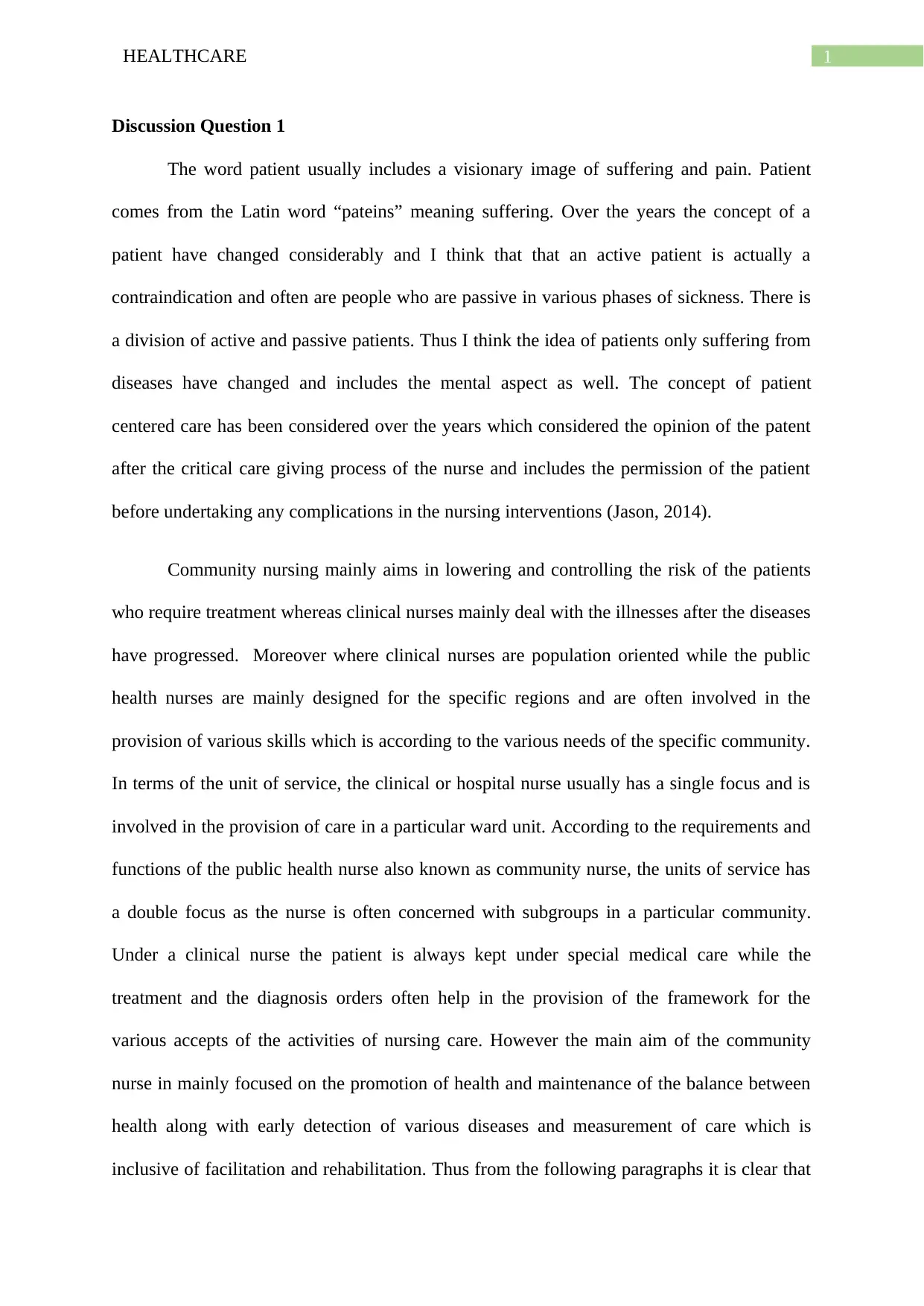
1HEALTHCARE
Discussion Question 1
The word patient usually includes a visionary image of suffering and pain. Patient
comes from the Latin word “pateins” meaning suffering. Over the years the concept of a
patient have changed considerably and I think that that an active patient is actually a
contraindication and often are people who are passive in various phases of sickness. There is
a division of active and passive patients. Thus I think the idea of patients only suffering from
diseases have changed and includes the mental aspect as well. The concept of patient
centered care has been considered over the years which considered the opinion of the patent
after the critical care giving process of the nurse and includes the permission of the patient
before undertaking any complications in the nursing interventions (Jason, 2014).
Community nursing mainly aims in lowering and controlling the risk of the patients
who require treatment whereas clinical nurses mainly deal with the illnesses after the diseases
have progressed. Moreover where clinical nurses are population oriented while the public
health nurses are mainly designed for the specific regions and are often involved in the
provision of various skills which is according to the various needs of the specific community.
In terms of the unit of service, the clinical or hospital nurse usually has a single focus and is
involved in the provision of care in a particular ward unit. According to the requirements and
functions of the public health nurse also known as community nurse, the units of service has
a double focus as the nurse is often concerned with subgroups in a particular community.
Under a clinical nurse the patient is always kept under special medical care while the
treatment and the diagnosis orders often help in the provision of the framework for the
various accepts of the activities of nursing care. However the main aim of the community
nurse in mainly focused on the promotion of health and maintenance of the balance between
health along with early detection of various diseases and measurement of care which is
inclusive of facilitation and rehabilitation. Thus from the following paragraphs it is clear that
Discussion Question 1
The word patient usually includes a visionary image of suffering and pain. Patient
comes from the Latin word “pateins” meaning suffering. Over the years the concept of a
patient have changed considerably and I think that that an active patient is actually a
contraindication and often are people who are passive in various phases of sickness. There is
a division of active and passive patients. Thus I think the idea of patients only suffering from
diseases have changed and includes the mental aspect as well. The concept of patient
centered care has been considered over the years which considered the opinion of the patent
after the critical care giving process of the nurse and includes the permission of the patient
before undertaking any complications in the nursing interventions (Jason, 2014).
Community nursing mainly aims in lowering and controlling the risk of the patients
who require treatment whereas clinical nurses mainly deal with the illnesses after the diseases
have progressed. Moreover where clinical nurses are population oriented while the public
health nurses are mainly designed for the specific regions and are often involved in the
provision of various skills which is according to the various needs of the specific community.
In terms of the unit of service, the clinical or hospital nurse usually has a single focus and is
involved in the provision of care in a particular ward unit. According to the requirements and
functions of the public health nurse also known as community nurse, the units of service has
a double focus as the nurse is often concerned with subgroups in a particular community.
Under a clinical nurse the patient is always kept under special medical care while the
treatment and the diagnosis orders often help in the provision of the framework for the
various accepts of the activities of nursing care. However the main aim of the community
nurse in mainly focused on the promotion of health and maintenance of the balance between
health along with early detection of various diseases and measurement of care which is
inclusive of facilitation and rehabilitation. Thus from the following paragraphs it is clear that
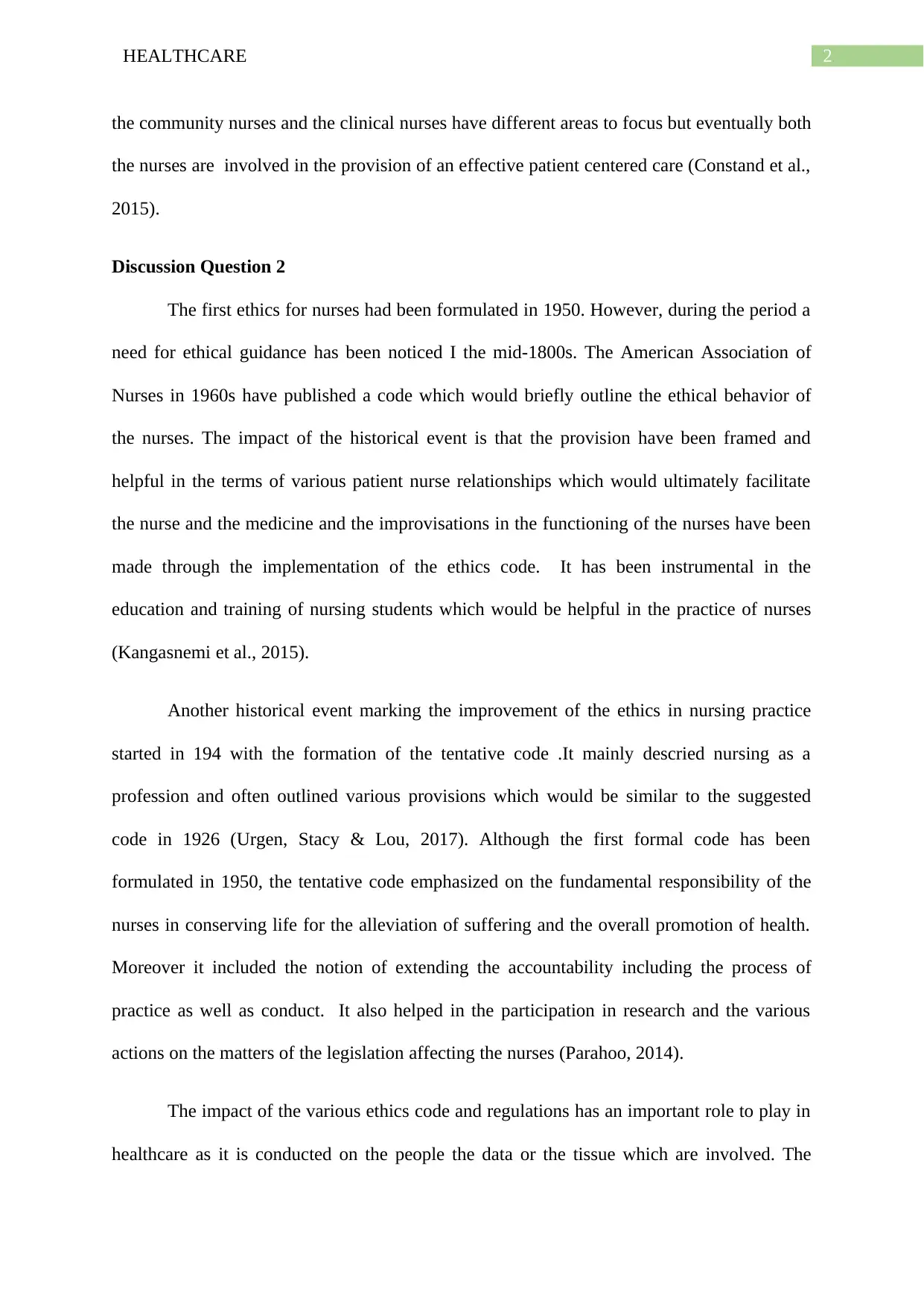
2HEALTHCARE
the community nurses and the clinical nurses have different areas to focus but eventually both
the nurses are involved in the provision of an effective patient centered care (Constand et al.,
2015).
Discussion Question 2
The first ethics for nurses had been formulated in 1950. However, during the period a
need for ethical guidance has been noticed I the mid-1800s. The American Association of
Nurses in 1960s have published a code which would briefly outline the ethical behavior of
the nurses. The impact of the historical event is that the provision have been framed and
helpful in the terms of various patient nurse relationships which would ultimately facilitate
the nurse and the medicine and the improvisations in the functioning of the nurses have been
made through the implementation of the ethics code. It has been instrumental in the
education and training of nursing students which would be helpful in the practice of nurses
(Kangasnemi et al., 2015).
Another historical event marking the improvement of the ethics in nursing practice
started in 194 with the formation of the tentative code .It mainly descried nursing as a
profession and often outlined various provisions which would be similar to the suggested
code in 1926 (Urgen, Stacy & Lou, 2017). Although the first formal code has been
formulated in 1950, the tentative code emphasized on the fundamental responsibility of the
nurses in conserving life for the alleviation of suffering and the overall promotion of health.
Moreover it included the notion of extending the accountability including the process of
practice as well as conduct. It also helped in the participation in research and the various
actions on the matters of the legislation affecting the nurses (Parahoo, 2014).
The impact of the various ethics code and regulations has an important role to play in
healthcare as it is conducted on the people the data or the tissue which are involved. The
the community nurses and the clinical nurses have different areas to focus but eventually both
the nurses are involved in the provision of an effective patient centered care (Constand et al.,
2015).
Discussion Question 2
The first ethics for nurses had been formulated in 1950. However, during the period a
need for ethical guidance has been noticed I the mid-1800s. The American Association of
Nurses in 1960s have published a code which would briefly outline the ethical behavior of
the nurses. The impact of the historical event is that the provision have been framed and
helpful in the terms of various patient nurse relationships which would ultimately facilitate
the nurse and the medicine and the improvisations in the functioning of the nurses have been
made through the implementation of the ethics code. It has been instrumental in the
education and training of nursing students which would be helpful in the practice of nurses
(Kangasnemi et al., 2015).
Another historical event marking the improvement of the ethics in nursing practice
started in 194 with the formation of the tentative code .It mainly descried nursing as a
profession and often outlined various provisions which would be similar to the suggested
code in 1926 (Urgen, Stacy & Lou, 2017). Although the first formal code has been
formulated in 1950, the tentative code emphasized on the fundamental responsibility of the
nurses in conserving life for the alleviation of suffering and the overall promotion of health.
Moreover it included the notion of extending the accountability including the process of
practice as well as conduct. It also helped in the participation in research and the various
actions on the matters of the legislation affecting the nurses (Parahoo, 2014).
The impact of the various ethics code and regulations has an important role to play in
healthcare as it is conducted on the people the data or the tissue which are involved. The
⊘ This is a preview!⊘
Do you want full access?
Subscribe today to unlock all pages.

Trusted by 1+ million students worldwide
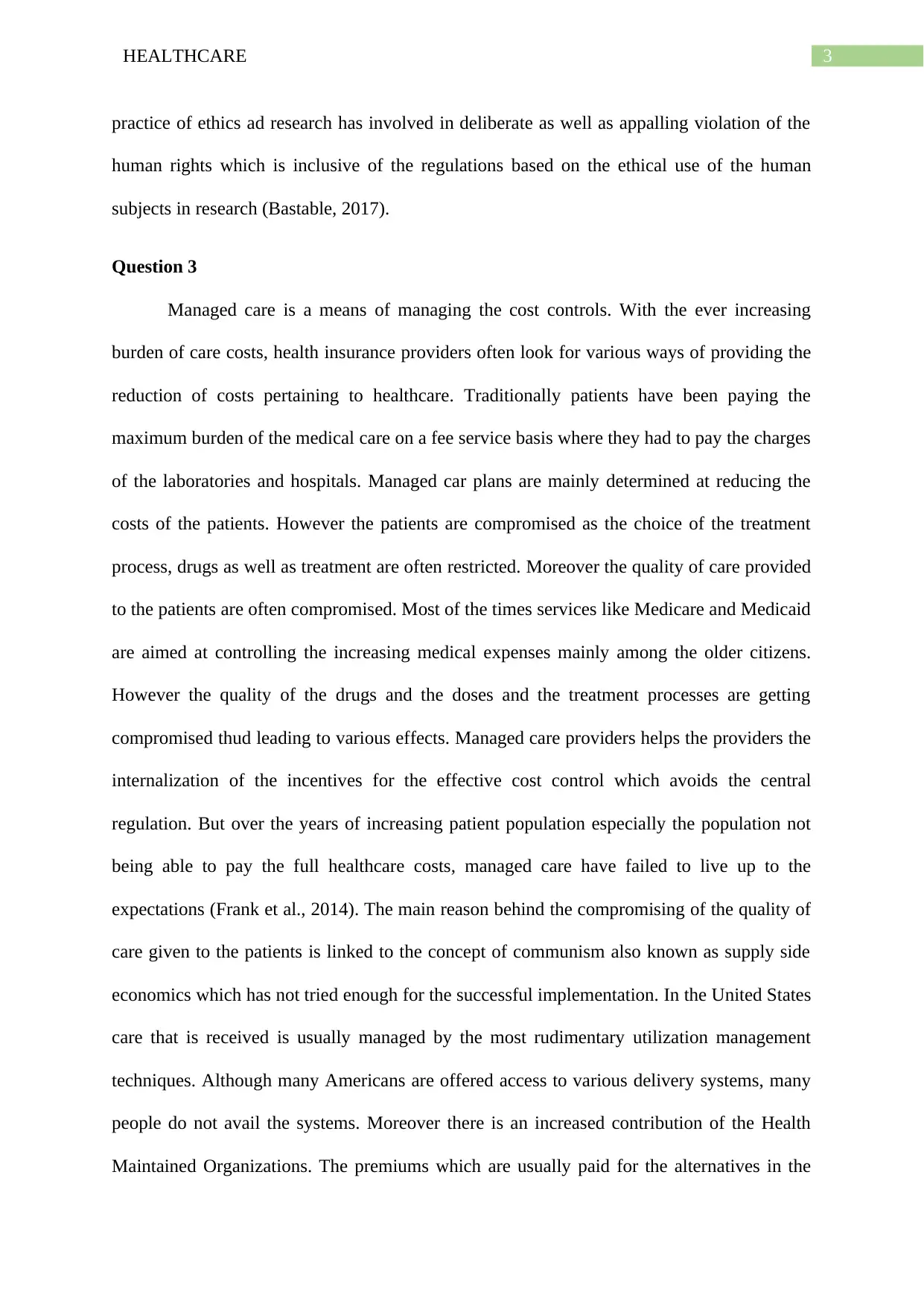
3HEALTHCARE
practice of ethics ad research has involved in deliberate as well as appalling violation of the
human rights which is inclusive of the regulations based on the ethical use of the human
subjects in research (Bastable, 2017).
Question 3
Managed care is a means of managing the cost controls. With the ever increasing
burden of care costs, health insurance providers often look for various ways of providing the
reduction of costs pertaining to healthcare. Traditionally patients have been paying the
maximum burden of the medical care on a fee service basis where they had to pay the charges
of the laboratories and hospitals. Managed car plans are mainly determined at reducing the
costs of the patients. However the patients are compromised as the choice of the treatment
process, drugs as well as treatment are often restricted. Moreover the quality of care provided
to the patients are often compromised. Most of the times services like Medicare and Medicaid
are aimed at controlling the increasing medical expenses mainly among the older citizens.
However the quality of the drugs and the doses and the treatment processes are getting
compromised thud leading to various effects. Managed care providers helps the providers the
internalization of the incentives for the effective cost control which avoids the central
regulation. But over the years of increasing patient population especially the population not
being able to pay the full healthcare costs, managed care have failed to live up to the
expectations (Frank et al., 2014). The main reason behind the compromising of the quality of
care given to the patients is linked to the concept of communism also known as supply side
economics which has not tried enough for the successful implementation. In the United States
care that is received is usually managed by the most rudimentary utilization management
techniques. Although many Americans are offered access to various delivery systems, many
people do not avail the systems. Moreover there is an increased contribution of the Health
Maintained Organizations. The premiums which are usually paid for the alternatives in the
practice of ethics ad research has involved in deliberate as well as appalling violation of the
human rights which is inclusive of the regulations based on the ethical use of the human
subjects in research (Bastable, 2017).
Question 3
Managed care is a means of managing the cost controls. With the ever increasing
burden of care costs, health insurance providers often look for various ways of providing the
reduction of costs pertaining to healthcare. Traditionally patients have been paying the
maximum burden of the medical care on a fee service basis where they had to pay the charges
of the laboratories and hospitals. Managed car plans are mainly determined at reducing the
costs of the patients. However the patients are compromised as the choice of the treatment
process, drugs as well as treatment are often restricted. Moreover the quality of care provided
to the patients are often compromised. Most of the times services like Medicare and Medicaid
are aimed at controlling the increasing medical expenses mainly among the older citizens.
However the quality of the drugs and the doses and the treatment processes are getting
compromised thud leading to various effects. Managed care providers helps the providers the
internalization of the incentives for the effective cost control which avoids the central
regulation. But over the years of increasing patient population especially the population not
being able to pay the full healthcare costs, managed care have failed to live up to the
expectations (Frank et al., 2014). The main reason behind the compromising of the quality of
care given to the patients is linked to the concept of communism also known as supply side
economics which has not tried enough for the successful implementation. In the United States
care that is received is usually managed by the most rudimentary utilization management
techniques. Although many Americans are offered access to various delivery systems, many
people do not avail the systems. Moreover there is an increased contribution of the Health
Maintained Organizations. The premiums which are usually paid for the alternatives in the
Paraphrase This Document
Need a fresh take? Get an instant paraphrase of this document with our AI Paraphraser
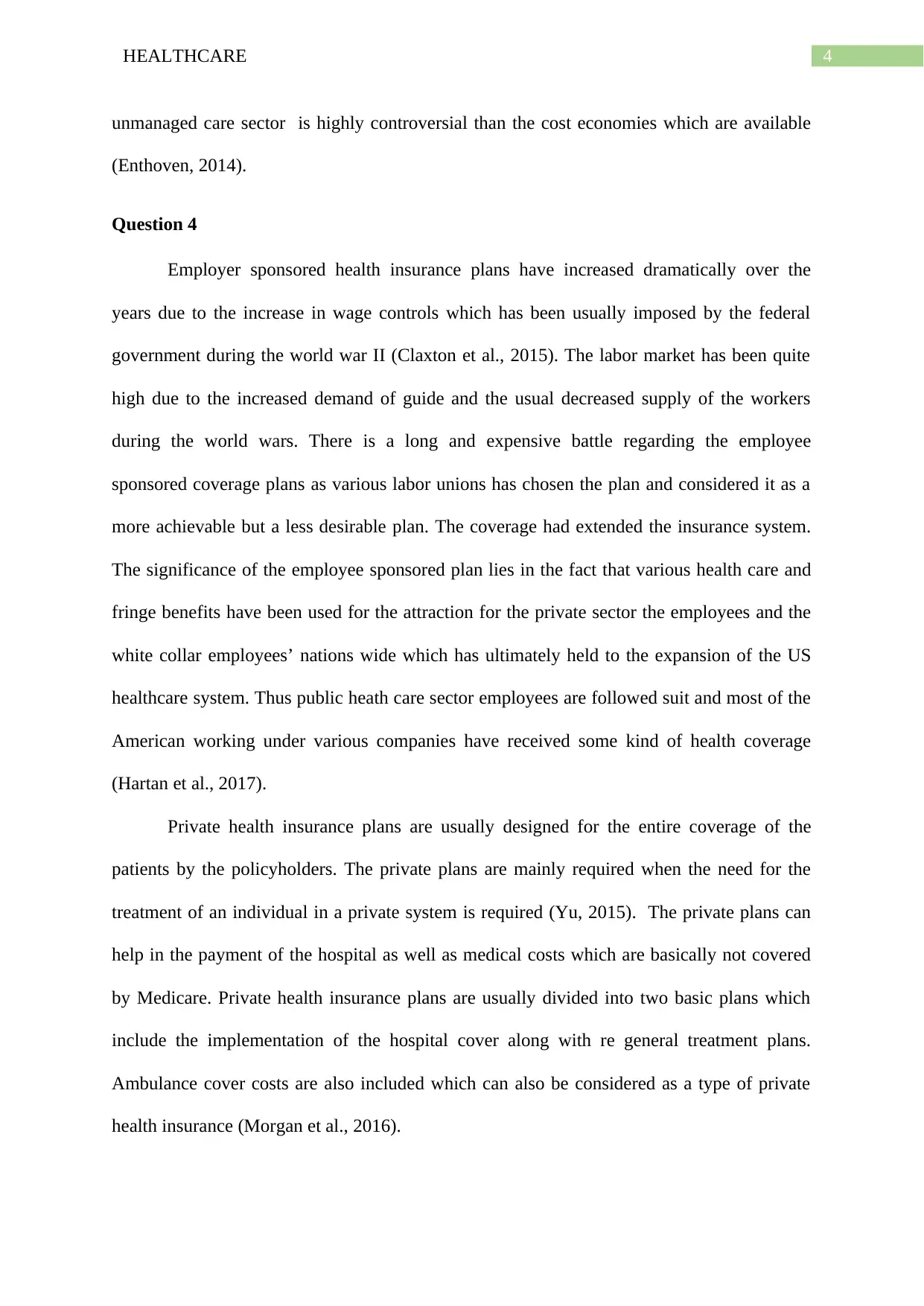
4HEALTHCARE
unmanaged care sector is highly controversial than the cost economies which are available
(Enthoven, 2014).
Question 4
Employer sponsored health insurance plans have increased dramatically over the
years due to the increase in wage controls which has been usually imposed by the federal
government during the world war II (Claxton et al., 2015). The labor market has been quite
high due to the increased demand of guide and the usual decreased supply of the workers
during the world wars. There is a long and expensive battle regarding the employee
sponsored coverage plans as various labor unions has chosen the plan and considered it as a
more achievable but a less desirable plan. The coverage had extended the insurance system.
The significance of the employee sponsored plan lies in the fact that various health care and
fringe benefits have been used for the attraction for the private sector the employees and the
white collar employees’ nations wide which has ultimately held to the expansion of the US
healthcare system. Thus public heath care sector employees are followed suit and most of the
American working under various companies have received some kind of health coverage
(Hartan et al., 2017).
Private health insurance plans are usually designed for the entire coverage of the
patients by the policyholders. The private plans are mainly required when the need for the
treatment of an individual in a private system is required (Yu, 2015). The private plans can
help in the payment of the hospital as well as medical costs which are basically not covered
by Medicare. Private health insurance plans are usually divided into two basic plans which
include the implementation of the hospital cover along with re general treatment plans.
Ambulance cover costs are also included which can also be considered as a type of private
health insurance (Morgan et al., 2016).
unmanaged care sector is highly controversial than the cost economies which are available
(Enthoven, 2014).
Question 4
Employer sponsored health insurance plans have increased dramatically over the
years due to the increase in wage controls which has been usually imposed by the federal
government during the world war II (Claxton et al., 2015). The labor market has been quite
high due to the increased demand of guide and the usual decreased supply of the workers
during the world wars. There is a long and expensive battle regarding the employee
sponsored coverage plans as various labor unions has chosen the plan and considered it as a
more achievable but a less desirable plan. The coverage had extended the insurance system.
The significance of the employee sponsored plan lies in the fact that various health care and
fringe benefits have been used for the attraction for the private sector the employees and the
white collar employees’ nations wide which has ultimately held to the expansion of the US
healthcare system. Thus public heath care sector employees are followed suit and most of the
American working under various companies have received some kind of health coverage
(Hartan et al., 2017).
Private health insurance plans are usually designed for the entire coverage of the
patients by the policyholders. The private plans are mainly required when the need for the
treatment of an individual in a private system is required (Yu, 2015). The private plans can
help in the payment of the hospital as well as medical costs which are basically not covered
by Medicare. Private health insurance plans are usually divided into two basic plans which
include the implementation of the hospital cover along with re general treatment plans.
Ambulance cover costs are also included which can also be considered as a type of private
health insurance (Morgan et al., 2016).
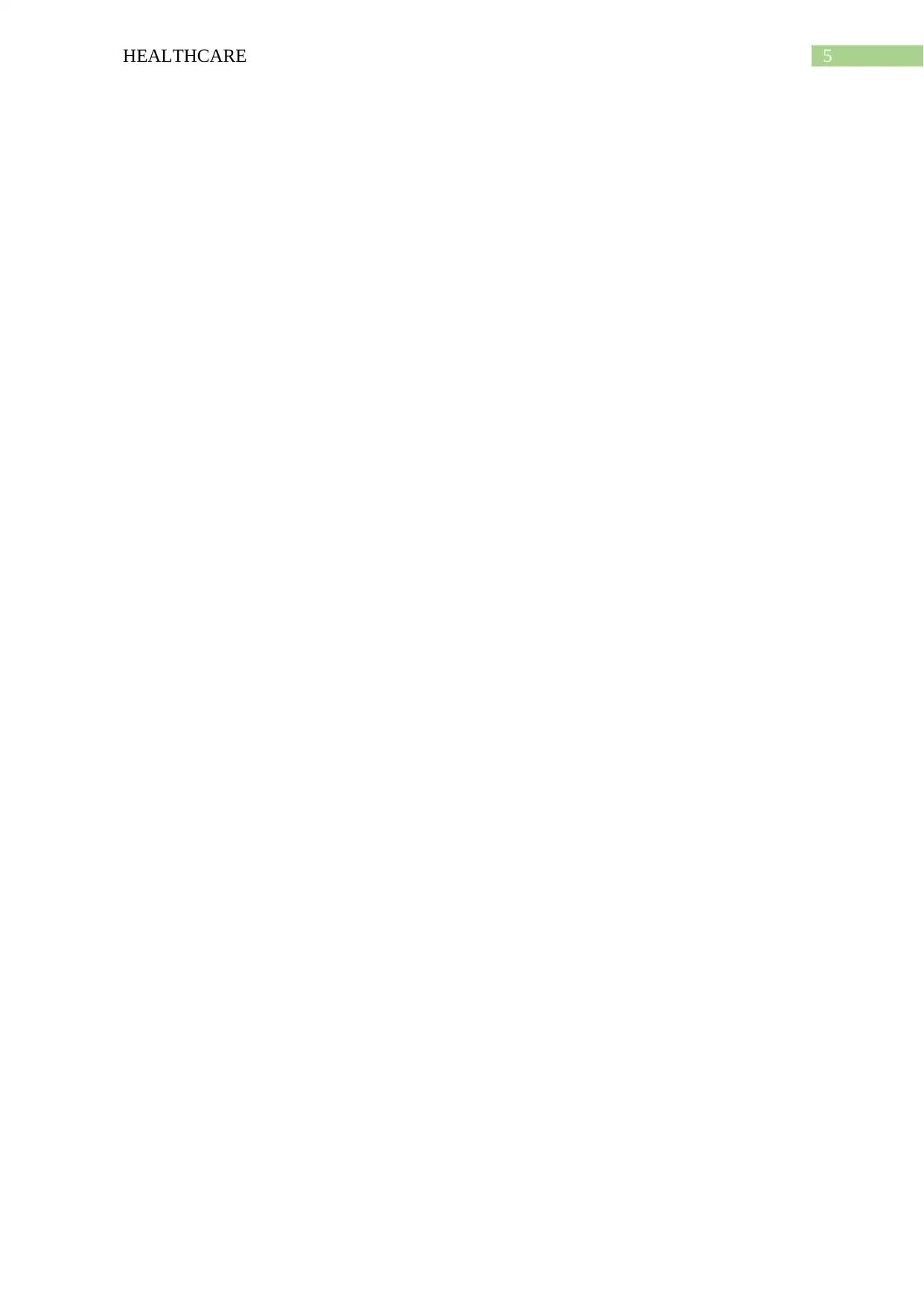
5HEALTHCARE
⊘ This is a preview!⊘
Do you want full access?
Subscribe today to unlock all pages.

Trusted by 1+ million students worldwide
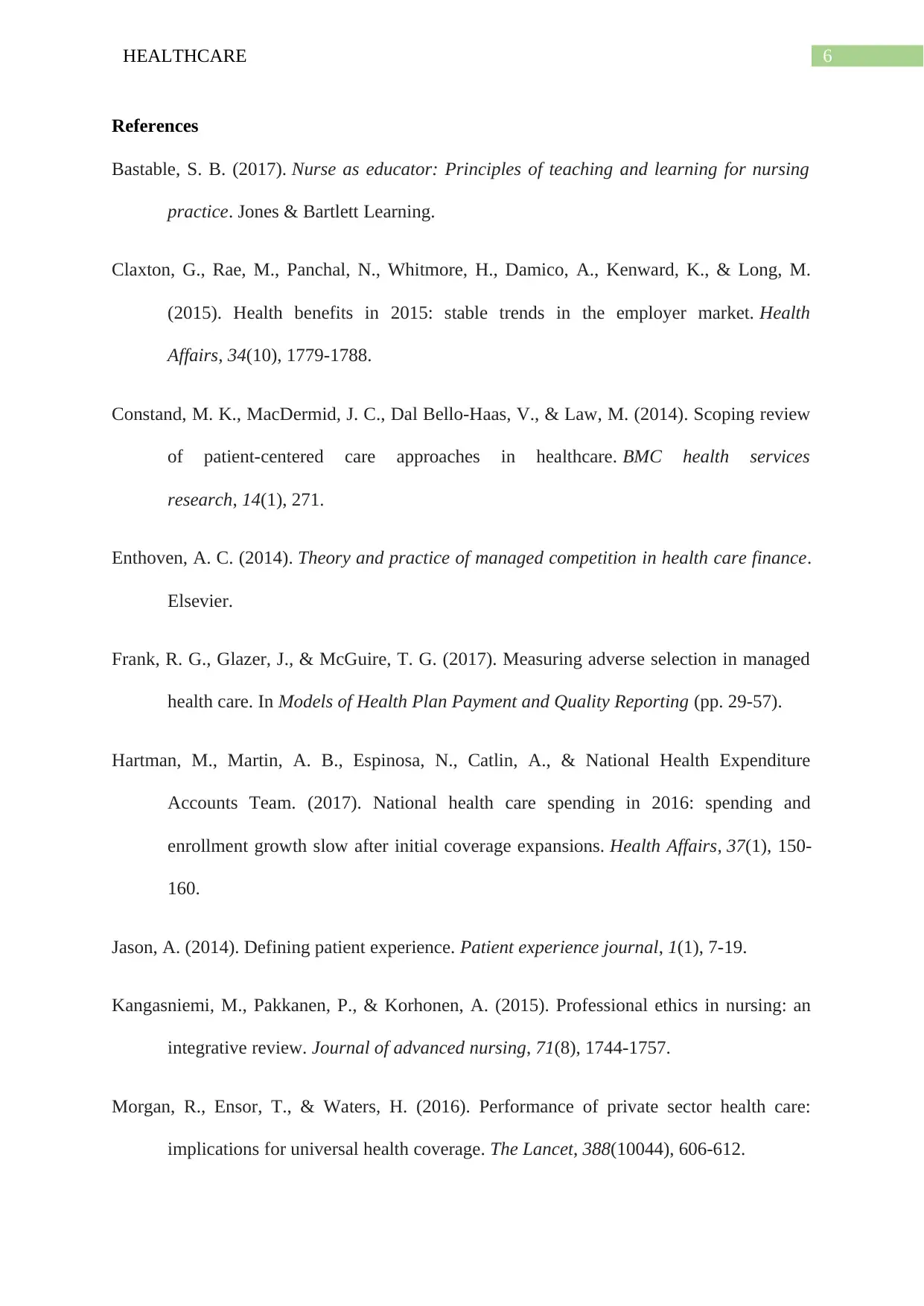
6HEALTHCARE
References
Bastable, S. B. (2017). Nurse as educator: Principles of teaching and learning for nursing
practice. Jones & Bartlett Learning.
Claxton, G., Rae, M., Panchal, N., Whitmore, H., Damico, A., Kenward, K., & Long, M.
(2015). Health benefits in 2015: stable trends in the employer market. Health
Affairs, 34(10), 1779-1788.
Constand, M. K., MacDermid, J. C., Dal Bello-Haas, V., & Law, M. (2014). Scoping review
of patient-centered care approaches in healthcare. BMC health services
research, 14(1), 271.
Enthoven, A. C. (2014). Theory and practice of managed competition in health care finance.
Elsevier.
Frank, R. G., Glazer, J., & McGuire, T. G. (2017). Measuring adverse selection in managed
health care. In Models of Health Plan Payment and Quality Reporting (pp. 29-57).
Hartman, M., Martin, A. B., Espinosa, N., Catlin, A., & National Health Expenditure
Accounts Team. (2017). National health care spending in 2016: spending and
enrollment growth slow after initial coverage expansions. Health Affairs, 37(1), 150-
160.
Jason, A. (2014). Defining patient experience. Patient experience journal, 1(1), 7-19.
Kangasniemi, M., Pakkanen, P., & Korhonen, A. (2015). Professional ethics in nursing: an
integrative review. Journal of advanced nursing, 71(8), 1744-1757.
Morgan, R., Ensor, T., & Waters, H. (2016). Performance of private sector health care:
implications for universal health coverage. The Lancet, 388(10044), 606-612.
References
Bastable, S. B. (2017). Nurse as educator: Principles of teaching and learning for nursing
practice. Jones & Bartlett Learning.
Claxton, G., Rae, M., Panchal, N., Whitmore, H., Damico, A., Kenward, K., & Long, M.
(2015). Health benefits in 2015: stable trends in the employer market. Health
Affairs, 34(10), 1779-1788.
Constand, M. K., MacDermid, J. C., Dal Bello-Haas, V., & Law, M. (2014). Scoping review
of patient-centered care approaches in healthcare. BMC health services
research, 14(1), 271.
Enthoven, A. C. (2014). Theory and practice of managed competition in health care finance.
Elsevier.
Frank, R. G., Glazer, J., & McGuire, T. G. (2017). Measuring adverse selection in managed
health care. In Models of Health Plan Payment and Quality Reporting (pp. 29-57).
Hartman, M., Martin, A. B., Espinosa, N., Catlin, A., & National Health Expenditure
Accounts Team. (2017). National health care spending in 2016: spending and
enrollment growth slow after initial coverage expansions. Health Affairs, 37(1), 150-
160.
Jason, A. (2014). Defining patient experience. Patient experience journal, 1(1), 7-19.
Kangasniemi, M., Pakkanen, P., & Korhonen, A. (2015). Professional ethics in nursing: an
integrative review. Journal of advanced nursing, 71(8), 1744-1757.
Morgan, R., Ensor, T., & Waters, H. (2016). Performance of private sector health care:
implications for universal health coverage. The Lancet, 388(10044), 606-612.
Paraphrase This Document
Need a fresh take? Get an instant paraphrase of this document with our AI Paraphraser
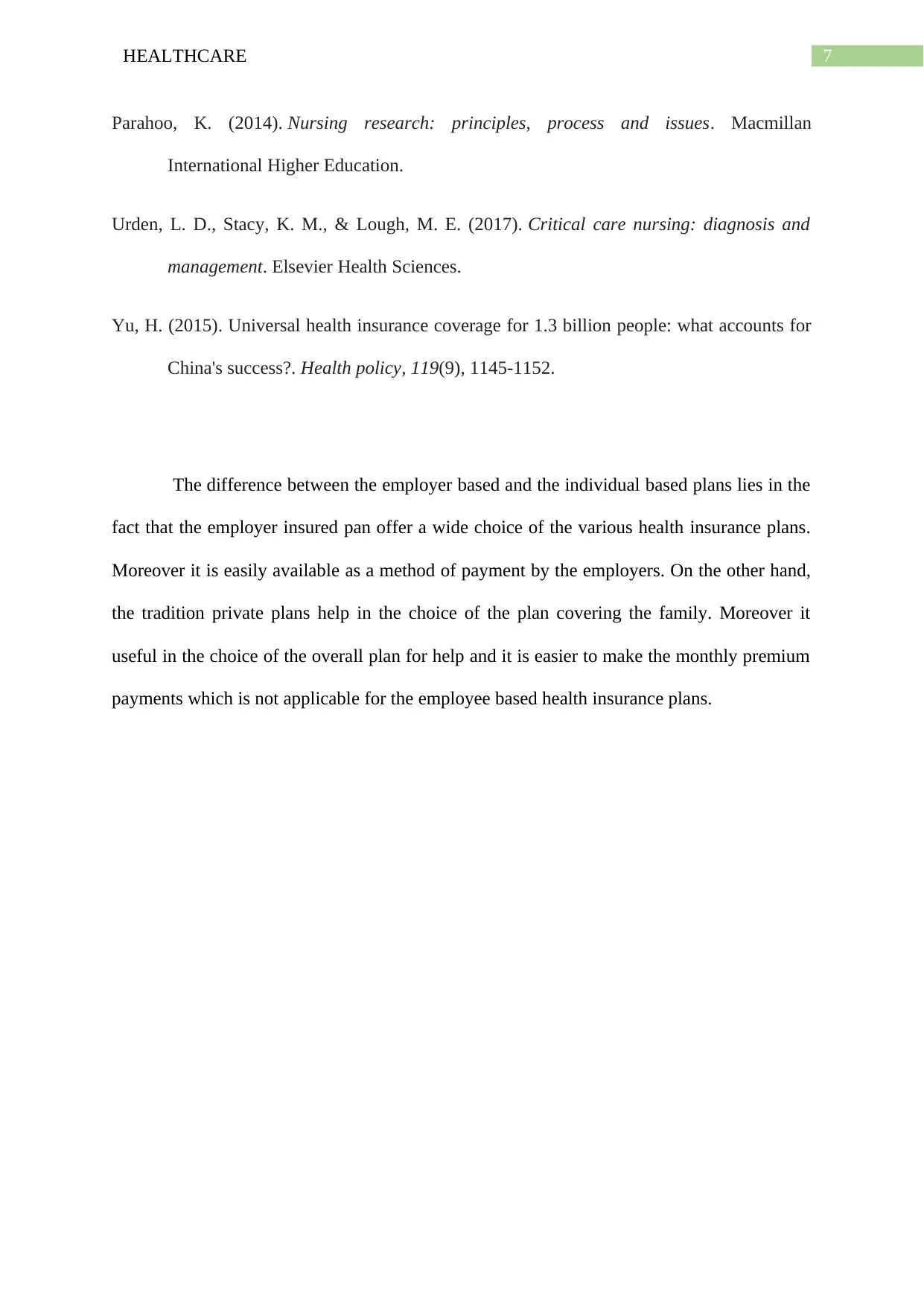
7HEALTHCARE
Parahoo, K. (2014). Nursing research: principles, process and issues. Macmillan
International Higher Education.
Urden, L. D., Stacy, K. M., & Lough, M. E. (2017). Critical care nursing: diagnosis and
management. Elsevier Health Sciences.
Yu, H. (2015). Universal health insurance coverage for 1.3 billion people: what accounts for
China's success?. Health policy, 119(9), 1145-1152.
The difference between the employer based and the individual based plans lies in the
fact that the employer insured pan offer a wide choice of the various health insurance plans.
Moreover it is easily available as a method of payment by the employers. On the other hand,
the tradition private plans help in the choice of the plan covering the family. Moreover it
useful in the choice of the overall plan for help and it is easier to make the monthly premium
payments which is not applicable for the employee based health insurance plans.
Parahoo, K. (2014). Nursing research: principles, process and issues. Macmillan
International Higher Education.
Urden, L. D., Stacy, K. M., & Lough, M. E. (2017). Critical care nursing: diagnosis and
management. Elsevier Health Sciences.
Yu, H. (2015). Universal health insurance coverage for 1.3 billion people: what accounts for
China's success?. Health policy, 119(9), 1145-1152.
The difference between the employer based and the individual based plans lies in the
fact that the employer insured pan offer a wide choice of the various health insurance plans.
Moreover it is easily available as a method of payment by the employers. On the other hand,
the tradition private plans help in the choice of the plan covering the family. Moreover it
useful in the choice of the overall plan for help and it is easier to make the monthly premium
payments which is not applicable for the employee based health insurance plans.
1 out of 8
Related Documents
Your All-in-One AI-Powered Toolkit for Academic Success.
+13062052269
info@desklib.com
Available 24*7 on WhatsApp / Email
![[object Object]](/_next/static/media/star-bottom.7253800d.svg)
Unlock your academic potential
Copyright © 2020–2025 A2Z Services. All Rights Reserved. Developed and managed by ZUCOL.





